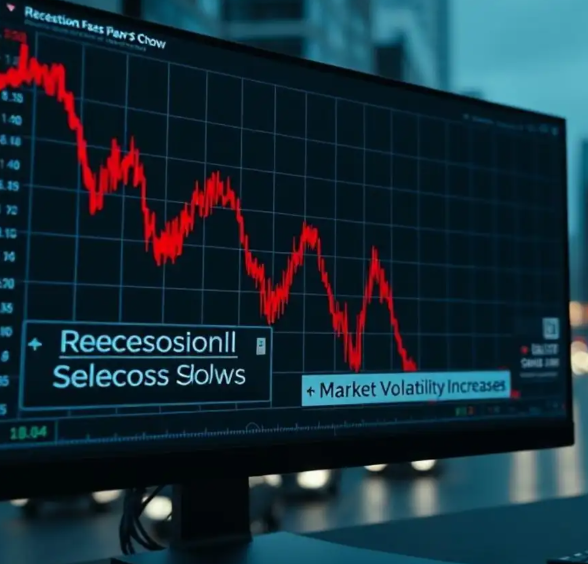Recession Still Not Imminent, But Stay Prepared for Slow Growth

As we move further into 2025, the economic landscape remains uncertain. With rising tariffs, shifting global dynamics, and a changing policy environment, many economists are adjusting their forecasts, but a recession is still not immediately on the horizon. While the risk of a downturn is higher than usual, the economy isn’t showing the typical signs of a recession just yet.
Rising Recession Risks
This year, I’ve adopted the theme “Three Yards and a Cloud of Dust” to describe the expected slow, steady growth that may be accompanied by noise and disruption. I’ve placed the probability of this scenario at about 60%. While I have also assigned a 25% chance to a recession occurring in 2025, this is based on current uncertainties—especially surrounding tariffs. Recently, many economists have raised their recession forecasts due to the unpredictability brought on by trade tensions, but I’m sticking with my 25% probability for now.
For comparison, the Wall Street Journal’s recent economic poll puts the chance of a recession at 22%, while some economists, like Ed Yardeni, have increased their forecast to 35%. Historically, the U.S. economy has entered a recession about 13% of the time since 1945, so even with the higher-than-normal chances of a recession this year, the likelihood of one occurring remains relatively low.
Factors Driving the Increased Recession Forecast
A key driver of the increased recession probabilities is the uncertainty stemming from tariffs and economic disruptions caused by these policy changes. The latest moves in tariffs, as well as shifts like Elon Musk’s ventures, are creating economic instability. This, in turn, has been reflected in declining consumer confidence and pessimism among small businesses. Investors, worried about the broader economic implications, are adjusting their expectations accordingly, leading to a modest contraction in the P/E ratio of stocks.
Econometric Models Indicate Mixed Signals
Econometric models provide mixed signals regarding the possibility of a recession. The Atlanta Federal Reserve’s GDP Now model, as of late March 2025, forecasts a 2.8% contraction in first-quarter GDP. On the other hand, the New York Federal Reserve’s Nowcast model predicts a 2.9% growth in GDP for the same period. The disparity in these forecasts is largely due to differences in inputs and assumptions, leading to ongoing debates about what direction the economy will take.
Why a Recession Isn’t Imminent
Despite the mixed signals from the models, I’m maintaining a 25% probability for a recession this year. Here’s why:
- Job Growth Remains Strong: In February, the U.S. economy added 151,000 jobs, and the unemployment rate remains low at 4.1%, well below the long-term average of 5.7%. Historically, recessions are often preceded by significant job losses, but we aren’t seeing that trend yet.
- Business Imports Are Up, But Not Final Demand: Businesses have been importing more goods in anticipation of higher tariffs, which has resulted in a $1.5 trillion swing in net imports. This impacts GDP growth, but it doesn’t necessarily indicate weakness in final demand.
- Stable Business Inventories: Business inventories increased by 2.3% year-over-year in January, largely driven by a rise in retail inventories. This suggests that businesses are preparing for continued demand, which is a positive sign.
- Money Supply and Bank Lending: The growth in the money supply (M2) has remained stable at about 4%, and bank lending activity has not collapsed. Commercial and industrial loans grew by 2.7% in the fourth quarter of 2024, which indicates ongoing business demand.
- No Major Warning Signs from Key Indicators:
- The Treasury yield curve isn’t fully inverted yet. A typical recession indicator, an inverted yield curve, is not currently present.
- The Leading Economic Indicators (LEI) are down by only 1.0%, whereas a recession typically requires a decline of at least 4.2%.
- Key purchasing managers’ indexes (PMI) for manufacturing and services remain above the recessionary threshold of 50, signaling healthy economic activity.
Slow Growth, But No Recession Yet
My current outlook remains one of slow, steady growth with a 60% probability, though the risks of a recession are higher than normal. Economic growth forecasts have been revised down in line with this expectation of slower growth, but they still predict positive growth for the year. We’re likely to experience a period of turbulence due to tariff uncertainty and broader market adjustments, but a full-blown recession isn’t currently on the horizon.
What Could Change?
For a recession to materialize, we would need to see several factors align. One potential trigger could be if the U.S. government succeeds in trade negotiations and tensions subside. Another could be aggressive tax cuts to offset the restrictive impact of tariffs, or the Federal Reserve could ease policy by cutting interest rates to stimulate economic activity.
In the meantime, I recommend staying calm and avoiding premature actions. The market is still fundamentally strong, with consumer spending, job growth, and business lending all showing resilience. While market volatility is expected to continue, those with a long-term focus should remain confident in the economy’s ability to recover and grow.
Conclusion
While the risk of a recession is higher than usual this year, I believe it’s still unlikely in the immediate future. The economy is showing resilience despite the challenges, and slow, steady growth remains the most likely outcome. As always, it’s important to stay informed, avoid knee-jerk reactions, and continue to focus on long-term goals as we navigate this period of uncertainty.


 English
English 












































































































































































































































































































































































